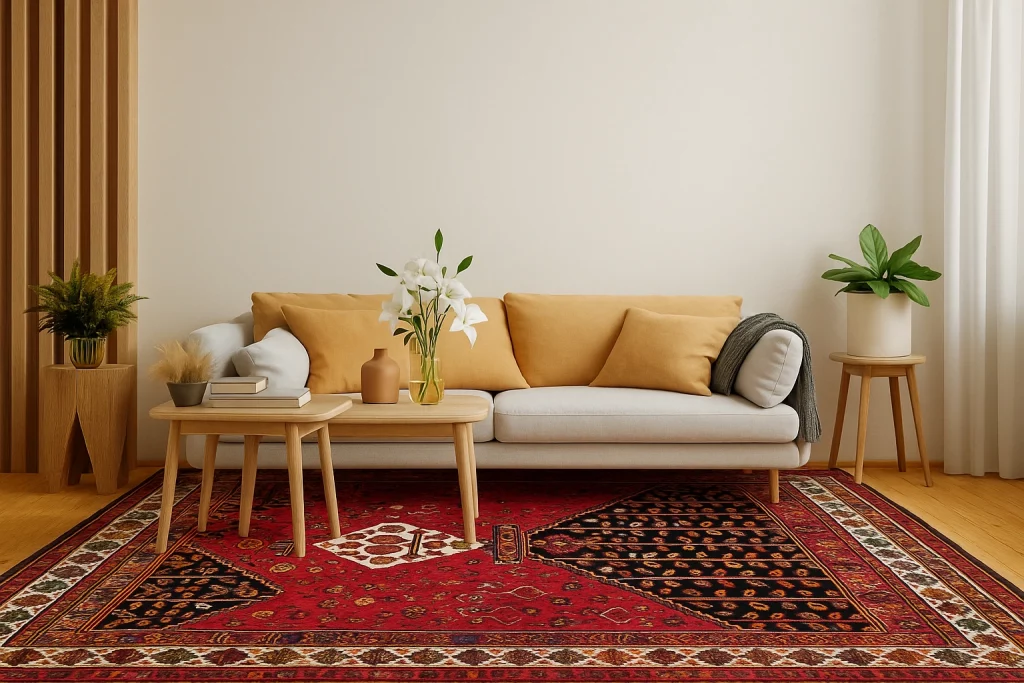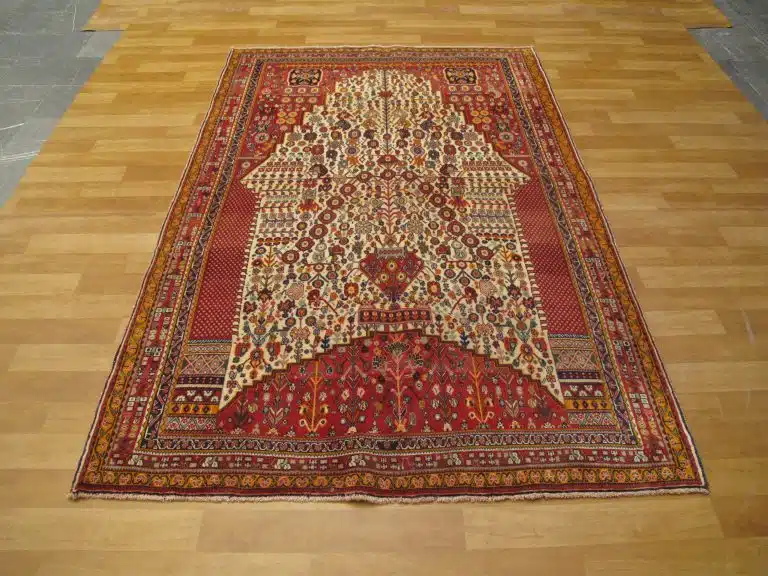Qashqai “Do-Sar Nazem” Carpets: A Nomadic Woman’s Dream of a Permanent Home
Persian carpets are never just floor coverings. They are stories told in knots, poems woven into wool, and personal diaries that capture the emotions, dreams, and hardships of their weavers. Among the many tribes of Iran, the Qashqai nomads stand out as masters of this craft. Their carpets are vibrant, soulful, and deeply connected to the rhythms of their nomadic lives.
One of the most fascinating designs in their weaving tradition is the “Do-Sar Nazem” carpet—literally, “Nazem at Both Ends.” More than just a pattern, it is a vision, a longing, a dream of home. It is the woven imagination of Qashqai women who, tired of endless migrations, wished for a place of safety and permanence.
In this article, we’ll explore the history, symbolism, artistry, and modern significance of these remarkable carpets.
A Short History of Qashqai Weaving
The Qashqai are one of Iran’s largest nomadic tribes, primarily based in Fars province in southern Iran. For centuries, they have migrated with their herds between summer and winter pastures. In such a lifestyle, possessions must be portable, practical, and durable. Carpets fit this world perfectly: they were bedding, shelter, dowry, and investment all at once.
But Qashqai carpets were never only functional. They became the voice of women, the primary weavers. Every carpet was a canvas for expressing hopes and frustrations, capturing landscapes of memory, and keeping cultural identity alive. Out of this tradition, the Do-Sar Nazem design was born.
✨See our Qashqai carpet collection.✨
What Does “Nazem” Mean?
In the Qashqai language, Nazem refers to the veranda or arch-like entrance of a house. It symbolizes a fixed home—a place that nomads rarely had. For Qashqai women, who spent their lives in tents and on the move, the idea of a permanent house was an unattainable luxury.
By weaving Nazem designs at both ends of the carpet, they created an imaginary house of their own. Each knot was a brick; each color, a memory. The carpet itself became their home.
Artistic Features of Do-Sar Nazem Carpets
1. Composition
•The defining feature is the arched structures at both ends of the rug, resembling gateways or porches.
•The center is filled with floral and vegetal motifs, almost like looking out into a blooming garden.
2. Colors
•Deep red (Lacquer/Crimson): warmth, energy, and passion.
•Dark blue (Navy/Indigo): strength and depth.
•Cream or ivory: a soft balance that brightens the whole composition.
The palette reflects the natural dyes available to nomads—madder root, indigo, walnut husks—creating tones that are both vibrant and earthy.
3. Motifs
•Floral patterns dominate, representing fertility and abundance.
•Occasionally, small animals like birds or goats appear, reflecting the pastoral world of the nomads.
•Every element feels spontaneous. Unlike workshop rugs, these designs were woven without a fixed cartoon (pattern drawing)—they flowed directly from memory and imagination.
4. Weaving Technique
•Knotted with the Turkish (symmetrical) knot.
•Wool is handspun and plant-dyed, often from the family’s own flock.
•Density is moderate (around 30–40 knots per 7 cm), prioritizing authenticity and expression over extreme fineness.

Symbolism and Philosophy Behind the Design
A Dream of Home
The Do-Sar Nazem carpet embodies a woman’s desire for stability in a life defined by constant movement. The two arches are not just patterns—they are doorways into her imagination, where she can finally rest in a house of her own making.
Life of Migration
•The pillars of the arches suggest strength and permanence.
•The curtain across the doorway symbolizes privacy and safety.
•The flowers and fields filling the background mirror the landscapes where the tribe lived and moved.
Union with Nature
To a Qashqai woman, nature was never outside the home—it was the home. That’s why the carpet bursts with flowers, trees, and open-air imagery.
Emotional and Social Role
Do-Sar Nazem rugs were rarely woven for sale. They were deeply personal:
•Often part of a dowry or woven for family use.
•Each piece served as a woven diary, carrying a woman’s voice into the future.
•The very act of weaving was therapeutic—a way of processing longing, hardship, and beauty at once.

Artistic Value Compared to Other Tribal Rugs
•Qashqai vs. Bakhtiari: warmer colors and more playful compositions.
•Qashqai vs. Turkmen: less rigid geometry, more organic and floral.
•Do-Sar Nazem in particular: unique for its dual-arch structure, which gives it a poetic symmetry unseen in most tribal weavings.
Modern Market and Global Appreciation
In Europe
Collectors see these rugs as artworks rather than furnishings. Their irregularity, spontaneity, and authenticity make them prized as unique cultural artifacts.
In the Gulf States
Countries like the UAE, Qatar, and Kuwait have shown strong appreciation for Qashqai rugs. The Do-Sar Nazem, with its arch-like forms reminiscent of Islamic architectural motifs, resonates particularly well with cultural tastes there.
Opportunities for Export
As global interest in sustainable, handmade, and authentic crafts grows, Do-Sar Nazem carpets are positioned perfectly to appeal to high-end buyers. They combine storytelling, artistry, and history in one tangible piece.
Challenges Facing Qashqai Weaving
•Machine-made imitations flood the market, lowering appreciation for authentic tribal rugs.
•International sanctions complicate exports from Iran, limiting access to collectors abroad.
•Decline of nomadism: as Qashqai families settle, the cultural context of such designs risks fading away.
Conclusion
A Do-Sar Nazem carpet is not simply wool on a loom. It is a woven dream, a house built by a woman who had none, a vision of rest amid endless migration.
Owning such a carpet is not just decorating a home—it is preserving a cultural poem, one that speaks of longing, resilience, and beauty.
In every knot, a woman has left a trace of herself: her hope for a home, her bond with nature, her refusal to let her story vanish. That is why Do-Sar Nazem carpets remain one of the most soulful expressions of Persian nomadic art, and why they deserve a place in homes, collections, and museums worldwide.
editor’s pick
editor's pick
latest video
news via inbox
Nulla turp dis cursus. Integer liberos euismod pretium faucibua

